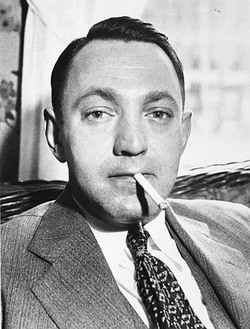How to make a killing by betting more than one horse
 In honor of the Las Vegas Mob Experience, a new interactive attraction that delves into the history of organized crime and its impact on Sin City, I have decided to discuss a particular betting style that (reputedly) got its name from one of America’s most notorious gangsters, Arthur Flegenheimer.
In honor of the Las Vegas Mob Experience, a new interactive attraction that delves into the history of organized crime and its impact on Sin City, I have decided to discuss a particular betting style that (reputedly) got its name from one of America’s most notorious gangsters, Arthur Flegenheimer.Flegenheimer, who was more popularly known as Dutch Schultz — a name derived from the trucking company he once worked for (Schultz Trucking) and the nickname of the company owner’s youngest son (Dutch) — gained notoriety for his involvement in both bootlegging and racketeering during the Prohibition era. Sometimes referred to as Al Capone’s accountant, the truth is Schultz never worked for Capone and, in fact, was based in New York, not Chicago, where Capone plied his “trade.”
Schultz did know his numbers, though. Upon learning that one of his associates, Jules Modgilewsky, a.k.a. Julie Martin (I know, that’s a pretty weak “a.k.a.”), was skimming money from him, Schultz shot Martin at point-blank range while dining with the gangster and two others at New York’s Harmony Hotel on the evening of March 2, 1935. Although the historical record doesn’t reveal who picked up the check that night, something tells me it wasn’t Schultz.
According to legend, Schultz was also pretty clever when it came to betting horses. The style of play known as “dutching” is said — although I’m not sure I believe it — to have been conceived by and named after the infamous mobster. In its purest form, dutching is designed to produce an equal amount of profit regardless of which horse wins a particular race. Of course, this can only be accomplished if one is reasonably sure that certain horses will not, or… uh… cannot, cross the wire first. How Schultz and associates attained such a level of confidence is open to debate, but I’m guessing it probably involved an offer that couldn’t be refused.
Though much harder to implement in a pari-mutuel system where the prices are constantly in a state of flux, dutching has been used in modern times as well. The late Howard Sartin, controversial founder of the “Sartin Methodology,” often advocated betting more than one horse to win in a race and others have done so as well. To me, there are three keys to successful dutching:
1) The odds must be right. Simply put, the amount wagered by the crowd on all of the horses being dutched cannot exceed 80 percent, or thereabouts, of the win pool (obviously, the lower the percentage, the better). Hence, if one is dutching without knowledge of the actual betting, it is imperative that a trusted morning line be used or that the handicapper is skilled enough to make an accurate line him/herself.Using some handpicked races from my Win Factor Report (computerized fair odds line) on Friday, April 22, I will attempt to show readers how one can make a killing by dutching in the New Millennium:
2) Careful consideration must be given to the type of race and the entrants one chooses to dutch. For example, isolating a couple of need-the-lead frontrunners might not be the wisest thing to do, as they are liable to run each other into the ground and set the race up for another, less-headstrong contender.
3) The race should feature a maximum of two outstanding entrants or 2-3 top contenders that figure to be massive overlays.

(Click on image to enlarge)
COMMENTS: The Win Factor Report Race Rating is a little low (55 percent), but the morning line odds and strength of the contenders compels me to look past that fact.
BET(S): 63 percent of base wager to WIN on 4, with the remaining 37 percent to WIN on 8.

(Click on image to enlarge)
COMMENTS: Given the closeness of the ratings past 5-ANGELS’ SHARE and the low morning line odds (3-1) on the second choice, 9-HAPPENSTANCE, this race is a pass from a dutching standpoint.

(Click on image to enlarge)
COMMENTS: This race can be dutched based solely on the generous morning line odds on 2-GOLDEN MENTOR (30-1, although the two Rated Starts are a red flag) and 3-CELENA (10-1).
BET(S): 64 percent of base wager to WIN on 9; 18 percent of base wager to WIN on both 2 & 3.

(Click on image to enlarge)
COMMENTS: This is a great race to dutch, as it features two strong contenders and a high Race Rating.
BET(S): 71 percent of base wager to WIN on 1; 29 percent of base wager to WIN on 4.

(Click on image to enlarge)
COMMENTS: Another good race to dutch, with just two primary contenders.
BET(S): 66 percent of base wager to WIN on 8; 34 percent of base wager to WIN on 7.

(Click on image to enlarge)
COMMENTS: This race is kind of tight among the secondary contenders, but 8-COURSER HANOVER figures to be a nice price and his Win Factor rating is relatively strong.
BET(S): 75 percent of base wager to WIN on 3; 25 percent of base wager to WIN on 8.
Do you know why students given too much homework? This is the main question of the day
ReplyDeleteThis comment has been removed by the author.
ReplyDeleteAmazing, Your blogs are really good and informative. I got a lots of useful information in your blogs. It is very great and useful to all. COMMENTS: This race is kind of tight among the secondary contenders, but 8-COURSER HANOVER figures to be a nice price and his Win Factor rating is relatively strong charlottesville virginia personal injury lawyers. Keeps sharing more useful blogs...
ReplyDelete